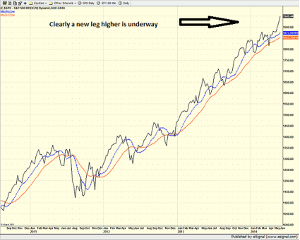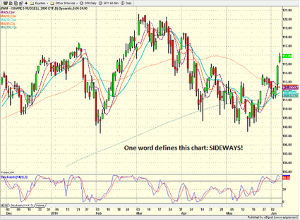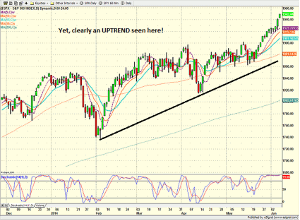David Moenning of StateoftheMarkets.com shares what his models say about the current market environment and how long it is likely to last.
Much to the chagrin of those residing in the glass-is-half-empty camp (who, by the way, felt that May was definitely going to be their time), stocks have embarked on a new leg higher. The breakout to the upside, and then more importantly, the follow-through and confirmation by multiple indices, was a surprise to just about everyone in the game (well, to those that are honest about their prognostications anyway).
However, the chart below clearly makes the case that a new leg of the bull market is underway.
S&P 500 – Daily
The bears have been pooh-poohing the move and have a lot to complain about at the present time including:
- Technical divergences
- Lack of confirmation
- Geopolitical issues
- Growth concerns
- Overbought conditions
- Age of the bull market
Our furry friends point to a chart of the Russell 2000 as Exhibit A in their list of complaints. This chart defines a sideways, choppy market that has been fraught with risk so far in 2014.
iShares Russell 2000 ETF (IWM) – Daily
And yet, the majority of the major indices, including the S&P 500, DJIA, S&P 400 Midcap, DJ Transportation, and the NASDAQ 100, all closed Friday at either new all-time or new cycle highs. Honestly, how can anyone argue that the chart of the S&P 500 is not bullish at the present time?
S&P 500 – Daily
While there are "issues" in the market and a pullback is to be expected in here at some point, the S&P 500 is clearly in an uptrend. As such, anyone whose goal is to stay in line with what the market IS doing has got to be bullish here, right?
So, Which Team is Right?
So, the question becomes: Which team is right? Will the current joyride to the upside end as abruptly as it began? Will the major decline that so many are looking for materialize soon? Or is this the next leg in a bull market that looks to be one for the record books?
Markets that confuse and confound are the reason many active risk managers (including yours truly) rely on models and indicators to guide their exposure to the market. Such an approach removes emotion and tends to keep investors on the proper side of the really big, really important moves in the market.
Will the current move turn out to be one of the really big, really important moves that make an investor's year? In all honesty, we can't know the answer. But what we can do is try to stay in tune with the market environment. Sure, an investor can get fooled using such an approach and "look" dumb for a few months here and there. But again, the goal is to get the big moves right year in and year out. And perhaps the best way to do so is to have unemotional models and systems to guide you.
How to Unemotionally Define the Market Environment
So, how does one unemotionally define the market environment? By building some market models, of course.
What follows is the approach used at my shop—an approach that has been developed and refined over the past 25 years. But to be clear, what follows is NOT the Holy Grail of market strategies. And what follows is likely NOT right for everyone. However, this method makes sense in terms of the way we view the market and is designed to "get it right" most of the time.
Step 1: Determine the Intermediate-Term Market Environment
The first step in the process involves defining the market environment on both the short- (defined as three days to three weeks) and intermediate-term (three weeks to three months) time frames.
This is accomplished by examining the reading of various market models. The first is the Weekly Environment Model, which is designed to indicate the intermediate-term environment, and includes the following 10 inputs:
- Intermediate-term Trend & Breadth Confirm Indicator
- Projection of Cycle Composite
- Demand Volume vs. Supply Volume Indicator
- Intermediate-term Investor Sentiment Model
- Economic Model
- Monetary Model
- Risk Environment Model
- Short-Term Trend Indicator
- Intermediate-Term Trend Indicator
- Industry Technical Health Model
NEXT PAGE: Two More Steps to Evaluating the Market’s Health
|pagebreak|Each model/indicator is given a score of +1 (positive), 0 (neutral), or -1 (negative). The indicator scores are then summed to produce the model reading. When the model reading is positive, history shows that it has paid to favor the bulls. When the model is negative, it has been a good idea to take less risk or even be short the stock market. And when the model is neutral, it indicates that the market is in a consolidation or "sloppy" period. Thus, this model will provide a big-picture indication of the overall market environment.
Step 2: Determine the Short-Term Market Environment
Next, a similar set of indicators is put together to create a daily version of the overall environment model. The idea here is to take the temperature of the market environment on a daily basis. Since markets can change on a dime these days, it is critical to not fall asleep at the switch.
This Daily Market Environment Model is used to help determine entry and exit points as well as the overall exposure to the markets.
Step 3: Determine If The Market Is Trending
The next step involves determining whether or not the current market is "trending" or not. This is a further enhancement to the concept of using the proper tools for the job and represents the latest addition to our indicator/model repertoire.
For example, if the market is in a "trending" mode, it makes sense to stay in line with the prices of the indices and to utilize trend-oriented indicators. Thus, when the market is in a "trending mode," an investor will want to emphasize or overweight trend indicators.
However, when the market is not trending well, the environment is considered to be "mean reverting" (think of this being a sideways type of market). In this type of environment, it is generally better to emphasize or overweight tactical trading indicators, which are often referred to as swing trading or mean reverting techniques.
The idea here is to utilize (or overweight) an approach that buys weakness and sells strength. Unlike trend-following, which is designed to ride the wave of the trend, mean reversion strategies look to utilize overbought/oversold conditions for entry and exit points.
To determine if the market is in a "trending" versus "mean reverting" mode, we employ three separate models—each designed to answer the same question. And when two out of the three models say the market is in a "trending" environment, it is a signal to overweight trend-following indicators (and vice versa).
So—What's the Bottom Line?
Currently the Intermediate-Term Environment Model is positive and has been for the past two weeks. Thus, the advantage should be given to the bulls from a bigger-picture standpoint.
Next, the Daily Environment Model is also positive—albeit, only modestly so—and has been since May 29. This is another indication that one should be leaning long here.
And finally, the Trending vs. Mean Reversion Models tell us that the market is NOW in a "trending mode." This is a relatively new development as the signal occurred last week.
So, while the current move could very easily turn out to be a "fakeout" (especially if a new "crisis" develops or things take a turn for the worse in Russia/Ukraine), the bottom line is the models indicate that the bulls should be given the benefit of the doubt and that the dips should be bought—for now.
However, since timing is indeed everything in this game, it is also worth noting that stocks are overbought at the present time and that a pullback to test the conviction of the move is to be expected in the coming days.
By David Moenning of StateoftheMarkets.com























